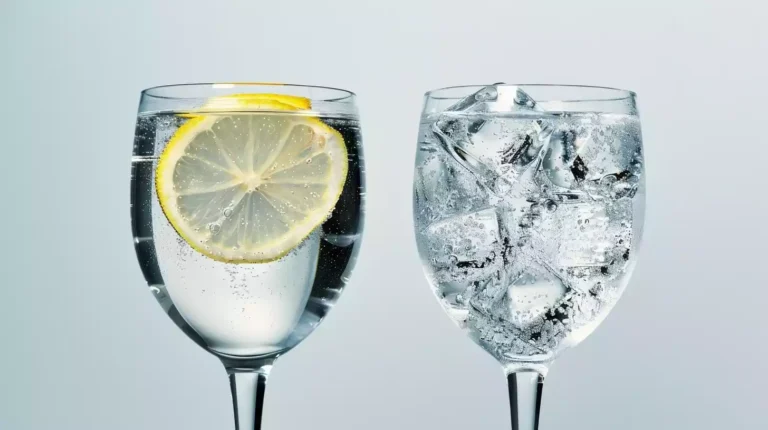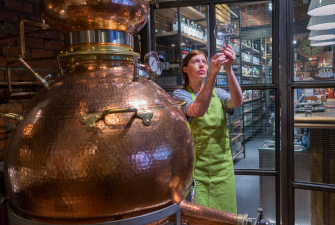Japanese gin vs Plymouth gin
Aside from the regular London Dry Gin, there are also many other types of gin, such as Japanese and Plymouth. You may know much about London Dry Gin, but what about Japanese gin vs Plymouth gin? How similar and different are they from each other?
Japanese and Plymouth gin are similar in that they are geographically-bound gin styles. Japanese gin can only come from Japan, and Plymouth gin must come from Plymouth. They are also lighter in taste. They can be different in history, production methods, and botanical use.
This article explores how Japanese and Plymouth gin are similar and different from each other.
What is Japanese Gin?
Japanese Gin is any gin made in Japan. Japanese Gin is known for its mellower, more complex flavor than London Dry Gin. Mixologists love to use it to create refreshing citrus drinks. Popular examples include Roku and Nikka Coffey Gin.
Japanese Gin refers to any gin that is distilled and made in Japan. Unlike London Dry Gin, Japanese gin can be made in all sorts of ways, which means you get to sample Japanese gins of all flavors and styles.
Such relaxed regulation allows Japanese gin makers to experiment around. For example, Japanese Gin uses the local spirit, Shochu, as base alcohol. Japanese distillers also tend to use a pot still to distill gin. Japanese Gin makers also like to add local Japanese botanicals.
Some local botanicals include Sakura flowers, green tea, or Yuzu peel. Japanese Gin distillers prefer building a more complex flavor rather than relying on Juniper berries.
Japanese Gin is softer on the juniper flavor. This allows you to taste other flavors in Japanese Gin. Japanese Gin is also popular with mixologists, as its lighter flavor makes it an excellent mixer.
QUICK TIP:
Popular Japanese Gin brands include Roku, Nikka Coffey Gin, and Ki No Bi.
What is Plymouth Gin?
Plymouth Gin is a style of gin that must be made in Plymouth, Britain. It is made of a specific blend of seven botanicals and uses grain spirit as its base alcohol. It has a milder juniper flavor with mild sweetness and spice. Plymouth Gin is popular with mixologists and chefs, who use it to make cocktails, sauces, and gravies.
Plymouth Gin is a style of gin. It is made in Plymouth, Britain, and is still made by the same establishment. It is one of the oldest gin brands still in production, having operated since 1793. This makes it even older than Beefeater (1862), Tanqueray (1830), or Bombay Sapphire (1986)
Plymouth Gin is protected by a geographical indication (GI) status. This means Plymouth Gin must be made within Plymouth and nowhere else. This makes Plymouth gin similar to many spirits such as Whisky (must be made in Scotland) or Cognac (must be made in Cognac, France.)
Plymouth gin is made using a specific blend of seven botanicals, which are:
- Juniper berries
- Coriander
- Angelica Root
- Orris Root
- Sweet Orange Peel
- Lemon Pool
- Cinnamon.
These botanicals are then infused with grain spirit before diluting to 41.2% Alcohol By Volume (ABV) using local Dartmoor water. Variants of Plymouth gin include Navy Strength Plymouth Gin, bottled at 57% ABV.
Plymouth Gin has a milder juniper flavor and a sweeter, spicier taste. It is considered a more versatile gin, making it a popular choice for cocktails and an ingredient to make sauces or gravies.
DID YOU KNOW?
Plymouth Gin is made by a single distillery, which gives it a single-malt whisky vibe.
How Are Japanese and Plymouth Gin Similar?
Japanese and Plymouth gin are similar in that both are geographically bound. Japanese Gin must come from Japan, and Plymouth Gin must come from Plymouth, Britain. Both gin styles are light on juniper, allowing additional flavors to come through.
Japanese Gin and Plymouth Gin cannot be further apart from each other. Japanese Gin is made on the Far Eastern side of the Old World, while Plymouth Gin is made on the Far Western side.
They surprisingly do share some similarities:
Geographically Bound
Both Japanese and Plymouth Gin have some geographical protection. It could be said that Plymouth Gin has done a stricter job, although Japanese Gin is not far behind.
Plymouth Gin must be made in Plymouth, Britain. It has also applied for Geographical Indication (GI) status to enforce this. This means you can make your gin exactly the same as Plymouth Gin, but you cannot call it Plymouth Gin unless you make them In the Plymouth district.
Japanese Gin may not have Geographical Indication (GI) status. However, people generally consider a gin Japanese Gin if it is distilled and bottled in Japan itself. Japanese Gin also tends to add local flavors and name their gin in Japanese, which makes it stand out.
Light On Juniper
Japanese and Plymouth Gin use Juniper berries in their botanicals but to a lesser degree than London Dry Gin. This makes Japanese and Plymouth Gin lighter on the Juniper flavor.
This allows additional flavorings to enter the gin, and gin makers exploit this. Japanese gin makers experimented with local botanicals such as Sakura flowers and Green tea. Plymouth Gin instead added in more citrus and spice.
As a result, Japanese and Plymouth gin can taste very different from popular gin types such as London Dry Gin.
How Are Japanese and Plymouth Gin Different?
Japanese and Plymouth Gin can differ in the:
- Origin
- History
- Production methods
- Botanicals used
- Taste and flavor
- Popular examples.
These differences help to set the two gins apart and help it to develop its own fans.
| Aspects | Japanese Gin | Plymouth Gin |
|---|---|---|
| Origin | Japan | Plymouth, United Kingdom |
| History | – Started in the 19th century due to a lack of imports | – Produced in the Barbican, Devon, since 1793. – Popular with the British Navy |
| Production Methods | – Tend to use a pot still – Tend to use Shochu as the base alcohol | – Grain spirit as base alcohol – Dartmoor water |
| Botanicals Used | – Common gin botanicals – Local Japanese botanicals | – Juniper berries – Coriander seed – Orange and lemon peel – Green cardamom – Angelica root – Orris root |
| Taste And Flavor | – Light, less juniper heavy – More floral with a slight sweetness | – Light, less juniper heavy – Slight sweetness – Hints of cardamom and coriander |
| Popular Brands | – Roku – Ki No Bi – Nikka Coffey Gin | – Plymouth Gin |
Origin
Japanese Gin is made and distilled in Japan, while Plymouth Gin has to come from the Plymouth district, Britain. Japanese Gin does not go into further details, such as determining districts where it must come from, unlike Plymouth Gin.
This means Japanese Gin can be made far up north in Hokkaido or Far South, such as in Okinawa, as long as they are in Japan. The same cannot be said for Plymouth Gin. It must be made in the Plymouth district and not for example in Newcastle or Manchester.
History
Japanese Gin’s history is of ingenuity, and self-sufficiency, with a hint of desperation. The Japanese first tasted gin sometime in the 17th century. Like the English, the Dutch brought in Jenever (the Dutch version of gin) and introduced them to it.
However, the Napoleonic Wars interrupted the trade, and Japan could not get its gin. This led to the localization of gin production, resulting in the Japanese gin we have today. This could have explained why Japanese gin uses so many local ingredients.
For example, the base alcohol is usually Shochu, and the botanicals are also local.
Want to learn more about Japanese gin? Read more about how did Japanese gin start?
Plymouth Gin’s history may be more related to quality and, surprisingly, morality and religion.
Christian monks first made Plymouth Gin in Black Friars distillery in 1793. The idea was to create a high-quality gin, to address social issues at the time.
Britain was deep in the Gin Craze during this time, and cities such as London were filled with working-class people drunk on cheap, low-quality gin.
These gins are so poorly made things such as methanol or poisonous compounds get in, causing instant blindness and death. Gin was even called ‘Mother’s Ruin,’ as women who often got drunk on gin ignored their children and turned to prostitution to feed their habit.
The monks decided to, instead, create a high-quality gin that was safe to drink. Plymouth Gin eventually became popular with the officers of the British Navy and so became a ‘gentleman’s drink’ of sorts. It is still being viewed as such today.
Production Methods
Both Japanese and Plymouth Gin use roughly similar processes to make gin. First, there was the distillation of the base alcohol. Then the botanicals are infused with it before the second distillation. Finally, the gin is diluted and bottled for sale.
The differences lie in the minor details.
For example, Japanese gin makers may use local Shochu as the base spirit. Shochu is a spirit that could be made of grains such as rice or wheat. Some Shochu could also be made from buckwheat and sweet potato.
Plymouth Gin does not specify what base alcohol to use. Apart from that, it needs to be grain alcohol.
Plymouth Gin also uses a more settled list of botanicals. At the same time, Japanese gin makers enjoy experimenting with the botanicals they want to use. This means Japanese Gin may have more variation in flavor than Plymouth Gin.
Botanicals Used
Plymouth Gin uses seven botanicals to make its gin. These are:
- Juniper berries
- Coriander
- Angelica Root
- Orris Root
- Sweet Orange Peel
- Lemon Pool
- Cinnamon.
Japanese Gins are known to be more experimental and liberal in their botanicals. Aside from using classic gin botanicals such as Juniper berries, they also use their local botanicals. These botanicals include, but are not limited to:
- Sakura flowers
- Yuzu peels
- Green tea
- Gyokuro tea
- Sanshu pepper.
Taste And Flavor
Plymouth and Japanese Gin may have different tastes and flavors. This is because they are made using a different approach and blends of botanicals.
Japanese Gin, in general, uses less juniper. It also uses more local botanicals and fewer sweeteners.
This resulted in a light-tasting gin with medium dryness. The juniper berry flavor is also not as strong as London Dry Gin.
Local Japanese botanicals also introduce flavors not found in other types of gin. Depending on the brand of Japanese gin, you may experience more herbal, floral, or fruity tastes.
Plymouth Gin is made with a set of botanicals, which means they are consistent in flavor. Similar to Japanese Gin, the juniper flavor is not too strong. Instead, you get more citrus and fruity taste with a hint of spice. It is also sweeter than London Dry Gin but less sweet than Old Tom Gin.
Want to learn more about the differences between Japanese vs. American Gin? We compared both.
Popular Brands
Japanese Gin is made by over 30+ distillers nationwide, with more joining in the art. This means you have a lot of distillers to choose from if you want to sample some Japanese gin. However, the more popular Japanese Gin in the markets include:
Nikka Coffey Gin: Nikka Coffey Gin may use a larger blend of fruits and citruses, helping to give it a more refreshing citrus and apple flavor. It also has a light Sanshu pepper hint, helping to make the gin drier on the finish. The gin is also clear in color, making it an excellent mixer.
Suntory Roku Gin: Roku may be the easiest Japanese Gin you can get. This is because it is made by Suntory, one of Japan’s largest makers of beverages. Suntory is also the maker of many award-winning Japanese whiskeys, such as Yamazaki and Hibiki.
Roku is Suntory’s play on gin. Roku translates to “six” in Japanese and refers to the six local botanicals used to make it. Roku has a floral, mellow tone and a green tea-derived tannic flavor.
For Plymouth Gin, since it is only made in a single district, there is only one sample you can get to taste it. This gives Plymouth Gin a similar vibe to single-origin coffee or single-malt whiskeys.
Plymouth Gin: Plymouth Gin may look old-fashioned outside, but take a sip and be surprised. You may first notice less juniper hit but more coriander and citrus peels. Swirl it around your mouth, and you may feel a bit of spice. Swallow it and appreciate the slightly dry finish.
Final Thoughts
Japanese and Plymouth gin may share certain similarities, such as being geographically bound and having a lighter taste, but they also have significant differences in their history, production methods, and use of botanicals.
It’s fascinating to learn about the unique characteristics of different types of gin, and it’s exciting to experiment with new flavors and styles.
Whether you’re a gin connoisseur or just starting to explore the world of gin, trying out Japanese and Plymouth gin is a must-do on your list.






